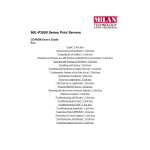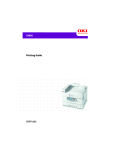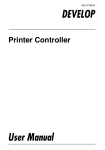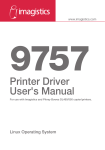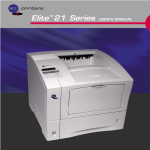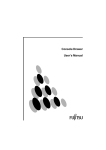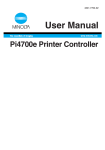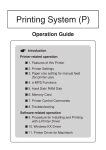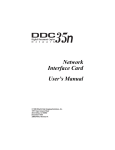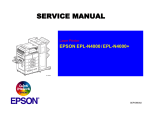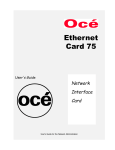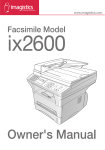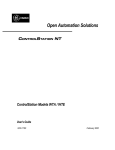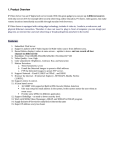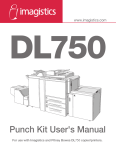Download "user manual"
Transcript
www.imagistics.com 9797 Printer Controller Basic User's Guide For use with Imagistics im5520 and im4720 Contents Contents 1 2 3 Before Using the Printer Driver 1.1 Features of the Controller ............................................................1-1 1.2 Connecting the Controller............................................................1-5 1.3 Settings Made on the Machine.....................................................1-5 Priority Device .................................................................................1-5 On Line / Ready ..............................................................................1-5 1.4 Installing the Printer Drivers ........................................................1-6 Installing the Printer Driver 2.1 Windows 95/98/Me ........................................................................2-1 Operating Environment ...................................................................2-1 Installing (Windows 95/98/Me) ........................................................2-2 Making General Settings Before Using the Printer .........................2-3 2.2 Windows 2000/XP..........................................................................2-4 Operating Environment ...................................................................2-4 Installing (Windows 2000/XP) .........................................................2-4 Making General Settings Before Using the Printer .........................2-6 2.3 Windows NT4.0..............................................................................2-7 Operating Environment ...................................................................2-7 Installation (Windows NT 4.0) .........................................................2-7 Making General Settings Before Using the Printer .........................2-9 2.4 Linux.............................................................................................2-10 Operating environment..................................................................2-10 Installation .....................................................................................2-10 Printer setting with X window System ...........................................2-12 2.5 Macintosh ....................................................................................2-13 Operating environment..................................................................2-13 Installation (Macintosh OS 7/8/9) ..................................................2-13 Installation (Mac OS X) .................................................................2-19 Network Settings 3.1 Introduction ...................................................................................3-1 3.2 Specifying the IP Address From the Printer’s Touch Panel .....3-1 Setting procedure............................................................................3-1 3.3 Peer-to-Peer Printing with TCP/IP ...............................................3-3 3.4 Peer-to-Peer Printing with IPX/SPX .............................................3-4 i Contents 4 5 6 3.5 LPR Printing.................................................................................. 3-5 3.6 IPP Printing ................................................................................... 3-6 3.7 Specifying network settings from Printer Management Utility.............................................................................................. 3-7 Access ............................................................................................ 3-7 Operation........................................................................................ 3-7 Logging In to the Admin Mode........................................................ 3-7 Network Tab ................................................................................... 3-8 Properties Settings 4.1 Description of each tab (Windows)............................................. 4-1 4.2 Description of each tab (Linux)................................................... 4-3 4.3 Print options (Macintosh OS 7/8/9) ............................................. 4-4 4.4 Print options (Mac OS X) ............................................................. 4-5 Network Interface Card 5.1 Getting ready ................................................................................ 5-1 Utility software (on the CD-ROM) ................................................... 5-2 System requirements...................................................................... 5-3 5.2 Setting up the network card ........................................................ 5-4 Connecting a network cable ........................................................... 5-4 Configuring the network card.......................................................... 5-4 Scanner Mode 6.1 7 ii Outline ........................................................................................... 6-1 E-Mail (Scan to E-mail)................................................................... 6-1 Folder (Scan to Server) .................................................................. 6-2 URL ................................................................................................ 6-3 Necessary Settings......................................................................... 6-4 Necessary Devices (servers).......................................................... 6-4 Printer Management Utility 7.1 System requirements ................................................................... 7-1 7.2 Access ........................................................................................... 7-2 Operation........................................................................................ 7-2 Entering the password.................................................................... 7-2 7.3 Screen configuration.................................................................... 7-3 Contents 8 Troubleshooting 8.1 Unable to Print...............................................................................8-1 Unable to Make Correct Settings / Unable to Print Exactly as Set.........................................................8-3 iii Contents User Instructions For the U.S.A. Users FCC Part 15-Radio Frequency Devices This device complies with Part 15 of the FCC Rules. Operation is subject to the following two conditions: (1) This device may not cause harmful interference, and (2) this device must accept any interference received, including interference that may cause undesired operation. NOTE This equipment has been tested and found to comply with the limits for a Class A digital device, pursuant to Part 15 of the FCC Rules. These limits are designed to provide reasonable protection against harmful interference when the equipment is operated in a commercial environment. This equipment generates, uses, and radiate radio frequency energy and if not installed and used in accordance with the instruction manual, may cause harmful interference to radio communications. Operation of this equipment in a residential area is likely to cause harmful interference in which case the user will be required to correct the interference at his own expense. WARNING The design and production of this unit conform to FCC Regulations, and any changes or modifications must be registered with the FCC and are subject to FCC control. Any changes made by purchaser or user without first contacting the manufacturer will be subject to penalty under FCC regulations. FCC-F02 This device must be used with shielded interface cables. The use of non-shielded cables is likely to result in interference with radio communications and is prohibited under FCC rules. For Canada Users Interference-Causing Equipment Standard (ICES-003 Issue 3) This Class A digital apparatus complied with Canadian ICES-003 Cet appareil numérique de la classe A est conforme à la norme NMB-003 du Canada. IC-F03 For European Users CE Marking (Declaration of Conformity) This product complies with the following EU directives: 89/336/EEC, 73/23/EEC and 93/68/EEC directives. This declaration is valid for the area of the European Union. This device must be used with shielded interface cables. The use of non-shielded cables is likely to result in interference with radio communications and is prohibited under EU directives. iv Contents For Users of the Class B regulation’s countries This device must be used with shielded interface cables. The use of non-shielded cables is likely to result in interference with radio communications and is prohibited under CISPR 22 rules and local rules. For Users except the Class B regulation’s countries WARNING This is a Class A product. In a domestic environment this product may cause radio interference in which case the user may be required to take adequate measures. This device must be used with shielded interface cables. The use of non-shielded cables is likely to result in interference with radio communications and is prohibited under CISPR 22 rules and local rules. v Contents Welcome Thank you for purchasing the printer controller. This Quick Start Guide explains how to run print cycles on the machine, to which the controller is connected. It also provides information about how to setup the Network Interface Card and operate the Digital Copier in a network environment. First read this manual carefully and thoroughly; then, keep it close at hand so you can refer to it whenever it becomes necessary. Some of the screens shown in this manual may look different from what you will view in actual applications. Trademark Acknowledgements Apple, AppleTalk, and Macintosh are registered trademarks of Apple Computer, Inc. Ethernet is a registered trademark of Xerox Corporation. PCL, HP LaserJet III, HP LaserJet IIISi, HP LaserJet 4Si, are registered trademarks of Hewlett-Packard Company. HP UNIX is a trademark of Hewlett-Packard Company. Linux is a registered trademark of Linus Torvalds. Microsoft, Windows, and Windows NT are registered trademarks of Microsoft Corporation. Netscape Communications, the Netscape Communications logo, Netscape Navigator, Netscape Communicator, and Netscape are trademarks of Netscape Communications Corporation. Novell and NetWare are registered trademarks of Novell, Inc. PostScript is a registered trademark of Adobe Systems, Inc. Red Hat is a registered trademark of Red Hat, Inc. Sun and Solaris are trademarks of Sun Microsystems, Inc. All other product names are trademarks or registered trademarks of their respective holders. The information contained in this manual is subject to change without notice. vi Before Using the Printer Driver 1.1 Features of the Controller Chapter 1 1 1 The controller is an image controller designed to use the machine as a printer, allowing you to print documents directly to the machine from a computer to which the controller is connected. The printer driver, which is used during printing, is equipped with various functions that make the most out of the features of the machine. They enable you to use the same functions as those offered by the machine. When actually running a print cycle, you can specify various functions of the machine on your computer screen. ✎ Note When using the controller, be sure to set the machine to the On Line state. Some functions offered by the machine cannot be combined, such as Staple and Hole-Punch, and some others may not be used because of a paper size involved. The functions that cannot be selected appear dimmed. Further, if functions that are incompatible with each other are specified, the Conflicts dialog box will appear, prompting you to change the settings. When this dialog box appears, check the details and reselect the functions to ensure function compatibility. Some settings, which are defied by the machine for the restricted combinations of different functions, can at times be accepted by the printer driver. If a print command is issued from the personal computer with such settings made, the machine does not produce the output correctly or abandons the job to produce nothing. Make sure that you make correct settings. 1-1 Before Using the Printer Driver Features of the Controller Features of the Controller Chapter 1 1 Before Using the Printer Driver Various Printing Functions G Makes prints that are sorted into complete sets of the originals or grouped into uncollated groups, each containing prints of one original. G Prints two pages of originals on both front and back sides of a single sheet of paper. Long Edge Binding G Enlarges or reduces the image on the original. G Prints two pages or four pages of originals on a single sheet of paper. Maximum of 16 pages of originals can be printed on a single sheet of paper. 2 up 1-2 Short Edge Binding 4 up 1 Prints four pages of originals to both front and back sides of a single sheet of paper. G Places text in the background. G Makes prints of complete sets of the originals, stapled together or punched for filing. Before Using the Printer Driver G By combining Collate with other finishing capabilities, you can make complete sets of documents for immediate delivery without having to do any further processing. G Chapter 1 Features of the Controller Adds a reference number (Distribution Number) to each document set during printing. 1-3 Features of the Controller Before Using the Printer Driver Chapter 1 1 G Prints only the cover on a different type of paper (such as colored paper). G Capable of printing on OHP transparencies. You can also insert interleaves, either blank or printed with the same contents as those on the OHP transparencies. G Folds copies during finishing. Crease 1-4 Half Folding Z-Folding Administrative Functions 1.2 G Different accounts can be managed for printing records, just as when using the machine as a copier. G Printing of confidential documents may be withheld until a legitimate password is entered on the machine. Connecting the Controller The controller is installed inside the machine. The installation procedures are to be performed by service personnel. The controller is connected to the computer by a printer cable or network cable. Power to the controller is supplied from the machine. ✎ Tip If you cannot print from your computer, make sure that the printer cable or network cable is connected to the corresponding connectors. 1.3 Settings Made on the Machine The following functions must be set on the machine using its Utility Mode, as they relate to the controller. Priority Device Select the priority use of the machine, either as a copier or printer. G Copier: The machine is used as a copier. G Printer: The machine is used as a printer. On Line / Ready G On Line key This function is the same as that available in ordinary printers as On Line/Off Line. Select On Line normally. A lit lamp indicates that the machine is in the On Line mode. G Ready Lamp Data can be transferred while this lamp stays lit up. The lamp remains blinking while data is being transferred. 1-5 Chapter 1 1 Before Using the Printer Driver Connecting the Controller Installing the Printer Drivers 1.4 Installing the Printer Drivers To make 100% use of the functions offered by the machine mounted with the controller, install the attached printer drivers in your computer. The controller is furnished with the following printer drivers: Before Using the Printer Driver Chapter 1 1 G PCL6 printer driver for Windows 95 G PCL6 printer driver for Windows 98/Me G PCL6 printer drive for Windows NT4.0 G PCL6 printer driver for Windows 2000/XP G PS printer driver for Windows 95/98/Me G PS printer driver for Windows NT4.0 G PS printer driver for Windows 2000/XP G PPD file for Macintosh G PPD Plugin for Mac OS X G PS print utility for Linux (Redhat, SuSE, Turbo, Open) Install the printer driver suitable for the operating system that runs on your computer. For installation procedures, see the relevant page as detailed below: 1-6 G Installing the Windows printer driver: Windows 95/98/Me (p. 2-1) Windows 2000/XP (p. 2-4) Windows NT4.0 (p. 2-7) G Installing the Macintosh PPD file and PPD Plugin file: See “2.5 Macintosh” on page 2-13. G Installing the Linux print utility: See “2.4 Linux” on page 2-10. Windows 95/98/Me This chapter describes the procedure for installing the printer driver on a Windows operating system, Linux, and Macintosh. 2.1 G Windows 95/98/Me For the operating environment and installation procedure for the Windows 95/98/Me printer driver, see page 2-1. G Windows 2000/XP For the operating environment and installation procedure for the Windows 2000/XP printer driver, see page 2-4. G Windows NT 4.0 For the operating environment and installation procedure for the Windows NT 4.0 printer driver, see page 2-7. G Linux For the operating environment and installation procedure for the Linux printer driver, see page 2-10. G Macintosh For the operating environment and installation procedure for the Macintosh printer driver, see page 2-13. Windows 95/98/Me Operating Environment This section explains the required environment for the printer driver. Before installing the printer driver, check that your computer meets the following requirements. If it doesn’t, the printer driver may not function properly. Personal computer IBM PC or compatible with Pentium 200MHz or higher CPU Operating system Windows 95 (English), Windows 98 (English) or Windows Me (English) Memory 64MB or more I/O interface Parallel Centronics interface (Conforming to IEEE1284) Network 10/100BaseT (UTP) Free space on hard disk 10MB or more (PCL6) 2MB or more (PS) 2-1 Chapter 2 Installing the Printer Driver Installing the Printer Driver 2 2 Windows 95/98/Me 2 Installing (Windows 95/98/Me) ✎ Chapter 2 Note Before starting to install the printer driver, be sure first to quit all other applications. 1 Click the Start button. From the menu that appears, select Settings, Installing the Printer Driver then click Printers. 2 The Printers window will appear. Double-click the Add Printer icon. 3 The Add Printer Wizard will appear. Follow the instructions that appears on your computer screen and make your choices. If you have problems during the installations, please refer to the User Manual in the CD-ROM that is included with the controller. When all the files have been copied from the CD-ROM, the corresponding icon will be added to the Printers window. This completes the installation. 2-2 Windows 95/98/Me 2 Making General Settings Before Using the Printer The printer driver requires setting of items that are common to all print jobs, including the port to which the printer cable is connected and optional devices configured with the machine. These settings must be made using properties dialog box available from the Properties command after the printer driver has been installed or whenever the operating environment is changed. The most common settings were made when the printer driver was installed, meaning that you do not usually bother to change them. Some items must, however, be changed in the following cases. Cases where changes are necessary Applicable property tab You want to add a comment to distinguish the printer from others General The computer’s connecting port has been changed You want to change the conditions for the display of a timeout error You want to designate a port to which the machine is connected via a network (this setting must be made on a computer connected to the machine via a network) Details This setting is not related to printing. Color Management You want to share the machine with other computers connected to the same network (this setting must be made on the computer directly connected to the machine) Sharing You want to change the setting in the Digital Copier 47cpm PCL6 or PostScript Properties dialog box. For details, see Chapter 4. Setup Paper Quality Device Options Setting Job Management Overlay 2-3 Installing the Printer Driver Note When installing the printer driver in a computer connected to the machine via a network, be sure to consult the network administrator. Chapter 2 ✎ Windows 2000/XP 2 2.2 Windows 2000/XP Operating Environment Chapter 2 This section explains the required environment for the printer driver. Installing the Printer Driver Before installing the printer driver, check that your computer meets the following requirements. If it doesn’t, the printer driver may not function properly. Personal computer IBM PC or compatible with Pentium 200MHz or higher CPU Operating system Windows 2000 (English) or Windows XP (English) Memory 64MB or more I/O interface Parallel Centronics interface (Conforming to IEEE1284) Network 10/100BaseT (UTP) Free space on hard disk 10MB or more (PCL6) 2MB or more (PS) Installing (Windows 2000/XP) ✎ Note When starting up the operating system, log in with administrator privileges. Before starting to install the printer driver, be sure first to quit all other applications. 1 For Windows XP, click the Start button. From the menu that appears, click Printers and Faxes. For Windows 2000, click the Start button, point to Settings, and then click Printers. 2 For Windows XP, the Printers and Faxes window will appear. Click the Add a printer icon. For Windows 2000, the Printers window will appear. Double-click the Add Printer icon. 2-4 Windows 2000/XP 2 Follow the instructions that appears on your computer screen and make your choices. If you have problems during the installations, please refer to the User Manual in the CD-ROM that is included with the controller. When all the files have been copied from the CD-ROM, the corresponding icon will be added to the Printers window. This completes the installation. ✎ Note When installing the printer driver in a computer connected to the machine via a network, be sure to consult the network administrator. 2-5 Installing the Printer Driver Chapter 2 3 Click the Next> button to start the Add Printer Wizard. Windows 2000/XP 2 Making General Settings Before Using the Printer Chapter 2 The printer driver requires setting of items that are common to all print jobs, including the port to which the printer cable is connected and optional devices configured with the machine. These settings must be made using property sheets available from the Properties command after the printer driver has been installed or whenever the operating environment is changed. Installing the Printer Driver The most common settings were made when the printer driver was installed, meaning that you do not usually bother to change them. Some items must, however, be changed in the following cases. 2-6 Cases where changes are necessary Applicable property tab You want to add a comment to distinguish the printer from others General You want to share the machine with other computers connected to the same network (this setting must be made on the computer directly connected to the machine) Sharing The computer’s connecting port has been changed You want to change the conditions for the display of a timeout error You want to designate a port to which the machine is connected via a network (this setting must be made on a computer connected to the machine via a network) Ports You want to restrict use condition of printer. You want to change settings in spool condition. You want to change OS-dependent settings. Advanced This setting is not related to printing. Color Management You want to restrict access to the machine You want to check the accounts of the machine users Security This setting is not related to printing. Processing You want to make settings for optional equipment installed on the machine. Device Options Setting Windows NT4.0 Windows NT4.0 This section explains the required environment for the printer driver. Before installing the printer driver, make sure that your computer meets the following requirements. If it doesn’t, the printer driver may not function properly. Personal computer IBM PC or compatible with Pentium 200MHz or higher CPU Operating system Windows NT4.0 (English) Memory 64MB or more I/O interface Parallel Centronics interface (Conforming to IEEE1284) Network 10/100BaseT (UTP) Free space on hard disk Chapter 2 Operating Environment Installing the Printer Driver 2.3 2 10MB or more (PCL6) 2MB or more (PS) Installation (Windows NT 4.0) ✎ Note When starting up the operating system, log in with administrator privileges. Before starting to install the printer driver, be sure first to quit all other applications. 1 Click the Start button. From the menu that appears, select Settings, then click Printers. 2 The Printers window will appear. Double-click the Add Printer icon. 2-7 Windows NT4.0 2 Installing the Printer Driver Chapter 2 3 Start the Add Printer Wizard. Follow the instructions that appears on your computer screen and make your choices. If you have problems during the installations, please refer to the User Manual in the CD-ROM that is included with the controller. When all the files have been copied from the CD-ROM, the corresponding icon will be added to the Printers window. This completes the installation. ✎ Note When installing the printer driver in a computer connected to the machine via a network, be sure to consult the network administrator. 2-8 Windows NT4.0 2 The most common settings were made when the printer driver was installed, meaning that you do not usually bother to change them. Some items must, however, be changed in the following cases. Cases where changes are necessary Applicable property tab You want to add a comment to distinguish the printer from others General The computer’s connecting port has been changed You want to change the conditions for the display of a timeout error You want to designate a port to which the machine is connected via a network (this setting must be made on a computer connected to the machine via a network) Ports You want to specify a time frame for the machine operation Scheduling You want to share the machine with other computers connected to the same network (this setting must be made on the computer directly connected to the machine) Sharing You want to restrict access to the machine You want to check the accounts of the machine users Security This setting is not related to printing. Pressing You want to make settings for optional equipment installed on the machine. Device Options Setting 2-9 Installing the Printer Driver The printer driver requires setting of items that are common to all print jobs, including the port to which the printer cable is connected and optional devices configured with the machine. These settings must be made using property dialog box available from the Properties command after the printer driver has been installed or whenever the operating environment is changed. Chapter 2 Making General Settings Before Using the Printer Linux 2 2.4 Linux Operating environment Chapter 2 This section explains the required environment for the printer driver. Installing the Printer Driver Before installing the printer driver, make sure that your computer meets the following requirements. If it does not, the printer driver may not function properly. Personal computer IBM PC or a compatible with a Pentium 200MHz or higher CPU Operating system Redhat Linux ver.6.1, 6.2 Turbo Linux ver.4.0, 6.0 Open Linux ver. 2.3, 2.4 SuSE Linux ver. 6.3, 6.4 Memory 64MB or more I/O interface Parallel Centronics interface (Conforming to IEEE1284) Network 10/100 Base-T (UTP) Free space on hard disk 2MB or more under /opt In this section, installation procedure is explained, referring to Redhat Linux. If a different procedure is used (depending on each OS), explanation is separately given for that section. Installation This section explains the installation procedure. X window System is described here. ✎ Note Before installing the printer driver, quit all other applications. 1 Log in with root when starting OS. 2 Start Terminal window. 3 Install the controller Driver CD-ROM provided with controller in the CD-ROM drive of your personal computer. 4 Copy RPM file to optional directory. The file has been stored in “/Linux/ PrintUtility” of the CD-ROM. 5 Input the following command to Terminal window and execute: # rpm –ivh diutil_pack_file 2-10 Linux 2 ✎ ✎ Note The installation procedure shown above cannot be used for the following Operating Systems. Use the installation procedure given on the next page: Open Linux ver. 2.4 SuSE Linux ver. 6.4 After installation is complete, the screen shown below will appear. If an error is output during installation, execute the following commands in sequence: # rpm -ivh diutil_pack_file --nodeps # ln -s /usr/lib/libtcl8.0.so /usr/lib/libtcl.so # ln -s /usr/lib/libtk8.0.so /usr/X11R6/lib/libtk.so # ldconfig -n /usr/lib/ # ldconfig -n /usr/X11R6/lib/ ✎ Note Input file name to “diutil_pack_file”. By executing the above commands in sequence, installation can be performed correctly. 2-11 Installing the Printer Driver 6 Installation will start when the above command has been executed. Chapter 2 Note Input file name to “diutil_pack_file”. Linux 2 Printer setting with X window System Making general settings before using the printer Chapter 2 The printer driver requires setting of items that are common to all print jobs, including the port to which the printer cable is connected and any optional devices configured with the machine: Note that these settings must be made only after the printer driver has been installed. Redhat Linux Installing the Printer Driver With Redhat Linux, setting is performed from Printer Configuration in the control panel. Turbo Linux With Turbo Linux, execute command from Terminal window for setting printer. Open Linux With Open Linux, printer setting can be performed using dialog box. SuSE Linux With SuSE Linux, command should be executed from Terminal window to set printer. How to display Printer Utility dialog box If you use X window, printer utility setting can be specified from dialog box. Dialog box can be displayed only with command operation, so didialog command is used here. Input the following command on the Terminal window and execute: The dialog box will appear. # /opt/diutil/bin/didialog –m [Model name] –P [Printer name] –a [Area] 2-12 G Specify the printer name which was designated during setting. G Input model name for [Model name]. G Specify [Area]; select [us] for Inch area, [ec] for Metric area. Macintosh Macintosh Before installing the printer driver, make sure that your computer meets the following requirements. If it doesn’t, the printer driver may not function properly. Operating system Apple Macintosh System7.5.3 or later, 8.x, 9.x or Mac OS X Personal computer Apple Macintosh computer or a Macintosh-compatible computer I/O interface Ethernet port Memory 16MB or more Disk drive CD-ROM drive is required for installation only. Free space on hard disk 2MB or more Recommended printer software LaserWriter 8.5.1. or later, LaserWriter 8.6 or later ✎ Note Do not use an Ethernet cable of low quality: Defective printing could result. Installation (Macintosh OS 7/8/9) This section explains the installation procedure for the Macintosh printer driver under Macintosh OS 7, 8 or 9. ✎ Note For details on the procedure for installing the printer driver on a Mac operating system, refer to “Installation (Mac OS X)” on page 2-19. The following procedures are concerned with Apple Macintosh system7.5.5 and LaserWriter8.5.1. ✎ Note When OS with other version or LaserWriter is used, procedures may vary slightly. Make sure that the controller and computer are properly connected to each other with an Ethernet cable. 2-13 Chapter 2 Operating environment Installing the Printer Driver 2.5 2 Macintosh 2 1 Turn ON the machine. 2 Turn ON the computer and start the Macintosh OS. Chapter 2 3 Install the printer controller CD-ROM in the CD-ROM drive of your computer. 4 Double-click the Macintosh HD icon on the desktop. Installing the Printer Driver 5 Double-click the System Folder. 6 Double-click Extensions folder. 7 Double-click Printer Description folder. 8 Drag the Digital Copier**cpm-PS.ppd file in the PPD folder of the CD-ROM to the Printer Description folder opened in step 7 to copy the file. ✎ Note Specify proper file according to the machine used. Digital Copier**cpm-PS.ppd Model name of the machine 2-14 Macintosh 2 9 Remove the CD-ROM from the CD-ROM drive. ✎ Installing the Printer Driver Note The steps that follow will apply when the LaserWriter printer driver has previously been installed in the Macintosh computer. Chapter 2 10 Select Chooser from the Apple menu. 11 The Chooser dialog box will appear. Click the LaserWriter icon. 2-15 Macintosh 2 12 The printer name set up with the NIC appears in the list under Select Installing the Printer Driver Chapter 2 a PostScript Printer. Select the printer and click the Create button. 13 The Select a PostScript Printer Description File dialog box will appear. Select Digital Copier 47cpm-PS.ppd from the dialog box and click the Select button. ✎ Note The following procedure is explained for Digital Copier, specified for inch area, as an example: Use by specifying proper file according to the machine used. 2-16 Macintosh 2 14 After the installation procedures have been completed, a small printer Installing the Printer Driver Chapter 2 icon will appear to the left of the printer name. 15 Click the Setup... button. 16 Click the Configure button. 2-17 Macintosh 2 17 Set the operating environment of the controller and click the OK but- Installing the Printer Driver Chapter 2 ton. ✎ Tip For details of the screen components, refer to the User Manual on the controller CD-ROM. 18 Click the OK button. 19 The Chooser dialog box will reappear. Close the Chooser dialog box. 2-18 Macintosh 2 Installing the Printer Driver Chapter 2 20 A printer icon will appear on the desktop. Installation (Mac OS X) This section explains the installation procedure for the Macintosh printer driver for Mac OS X. ✎ Note This printer driver is compatible with Mac OS X version 10.2 or later. 1 Turn on the machine. 2 Turn on the computer and start up the Mac OS. ❍ When starting up Mac OS, log in with administrator privileges. 3 Install the printer controller CD-ROM in the CD-ROM drive of your computer. 4 Copy Digital Copier 47cpm-PS.ppd and Digital Copier PPD Plugin.dmg to the desktop from the PPD folder on the CD-ROM. 5 Double-click Digital Copier PPD Plugin.dmg, which was copied to the desktop. 2-19 Macintosh 2 6 Double-click Digital Copier PPD Plugin.pkg to start it. ❍ The PPD Plugin installer starts up. Installing the Printer Driver Chapter 2 7 Click the Continue button. 8 Select the partition where the software will be installed, and then click the Continue button. As an example, the dialog box below shows the installation on the OSX disk. 2-20 Macintosh 2 9 Click the Install button. Installing the Printer Driver Chapter 2 The plugin for Digital Copier PPD is installed. 10 Click the Close button. This completes the installation of the PPD plugin. Next, install the Digital Copier printer driver. 11 Double-click the MacOSX icon on the desktop. 12 Click the Application icon 13 Double-click the Utility folder. 14 Double-click the PrintCenter icon. 15 Click the Add... button. 2-21 Macintosh 2 Installing the Printer Driver Chapter 2 16 Select Other... beside Printer Model:. 17 Select either Digital Copier 47cpm-PS.ppd, which were copied to the desktop in step 4, and then click the Choose button. 2-22 Macintosh 2 18 Select the appropriate printer model, and then click the Add button. Installing the Printer Driver Chapter 2 The Digital Copier printer driver is installed. 19 From the Printers menu, click Show Info. The Printer Info property dialog box appears. 20 Select Installable Options. 2-23 Macintosh 2 Installing the Printer Driver Chapter 2 21 Enter the printer settings, and then click the Apply Changes button. ✎ Note For details on the screen components, refer to the User Manual on the controller CD-ROM. 22 Close the Print Center dialog box. 2-24 Introduction 3 Network Settings 3.1 Introduction 3 There are two ways you can print from Windows NT 4.0 with TCP/IP: using the bundled IP Peer-to-Peer Printing Program, and using the Windows NT standard LPR printing function. There are two ways you can print from Windows 2000/XP with TCP/IP: using the Windows 2000/XP standard LPR printing function, and using the Windows 2000/XP standard IPP printing function. 3.2 Specifying the IP Address From the Printer’s Touch Panel Setting procedure 1 Press the [Utility] key. 2 Touch [Administrator Mode] and input the Administrator code. 3 Touch [NetworkSet]. 3-1 Network Settings A Windows 95/98/Me network printer can be used by going through a Novell NetWare or Windows 2000/NT server. This Network Card, however, can be configured with its bundled peer-to-peer printing programs for peer-to-peer printing without a server. Peer-to-peer printing can be performed using TCP/IP or IPX/SPX. Chapter 3 Though this Network Card does not support NetBEUI protocol, it supports TCP/IP and IPX/SPX, which provides plenty of connection flexibility for the Windows computer. 3 Specifying the IP Address From the Printer’s Touch Panel Chapter 3 4 Touch [IP Address]. 5 With the keypad in the oper- Network Settings ation panel, type in the IP address, and then touch [Enter]. 6 With the keypad in the operation panel, type in the subnet mask, and then touch [Enter]. 7 With the keypad in the operation panel, type in the default gateway, and then touch [Enter]. 8 In order to activate the address settings, turn the printer off, then on again. 3-2 Peer-to-Peer Printing with TCP/IP Peer-to-Peer Printing with TCP/IP Use the bundled IP Peer-to-Peer Printing Program for TCP/IP peer-topeer printing under Windows. Chapter 3 Digital Copier Network Card TCP/IP Network Settings 3.3 3 Windows TCP/IP IP Peer to Peer Printing Program ✎ Note Refer to the User Manual on the controller CD-ROM for details. Peer-to-Peer Printing Program is a Windows utility that lets you output directly to a printer from a computer on a network, without going through a server. Use this program for peer-to-peer printing under TCP/IP. Requirements G Computer must have TCP/IP installed and enabled. G Network Card must have valid IP parameters assigned. ✎ Note Refer to the applicable Windows documentation for information about installing TCP/IP under Windows. Refer to the User Manual on the controller CD-ROM for details. 3-3 Peer-to-Peer Printing with IPX/SPX 3 3.4 Peer-to-Peer Printing with IPX/SPX Use the bundled IPX Peer-to-Peer Printing Program for IPX/SPX peer-topeer printing under Windows. With IPX Peer-to-Peer Printing Program, there is no need to run NetWare Client. Chapter 3 Digital Copier Network Card Network Settings IPX/SPX Windows 95/98/Me IPX/SPX-compatible Protocol IPX Peer to Peer Printing Program ✎ Note Refer to the User Manual on the controller CD-ROM for details. Use this program for peer-to-peer printing under IPX/SPX. Just by installing this program, you can specify an IPX-based printer on the network as a printer port. Requirements G Computer must have IPX/SPX-compatible protocol installed. ✎ Note Refer to the applicable Windows documentation for information about installing IPX/SPX under Windows. Refer to the User Manual on the controller CD-ROM for details. 3-4 LPR Printing LPR Printing This section explains how to use the Windows NT 4.0/2000/XP standard LPR printing function. Chapter 3 Digital Copier Network Card TCP/IP Network Settings 3.5 3 Windows NT 4.0/2000/XP TCP/IP Microsoft TCP/IP Printing ✎ Note Refer to the User Manual on the controller CD-ROM for details. Requirements G Computer must have TCP/IP installed and enabled. G Network Card must have valid IP parameters assigned. 3-5 IPP Printing 3 3.6 IPP Printing This section explains how to use the Windows 2000/XP standard IPP printing function. Chapter 3 Digital Copier Network Card Network Settings IPP Windows 2000/XP TCP/IP IPP Client ✎ Note Refer to the User Manual on the controller CD-ROM for details. Requirements 3-6 G Computer must have TCP/IP installed and enabled. G Network Card must have valid IP parameters assigned. Specifying network settings from Printer Management Utility Specifying network settings from Printer Management Utility Access Printer Management Utility can be accessed directly from a Web browser. 2 In the URL field, enter the IP address of the printer controller as shown below. http://<IP address of printer controller>/ (Example) When the IP address of the printer controller is 192.9.200.200: http://192.9.200.200/ 3 This causes Printer Management Utility screen to appear. Operation Printer Management Utility operation is identical to that for Internet Web pages. Clicking a hot link jumps to the link destination, and the Back and Forward buttons scroll through pages backwards and forward. Logging In to the Admin Mode After you log in to Printer Management Utility in the Admin Mode, you can change the configuration of the Digital Copier settings. 1 Type the administrator password into the Admin Password box. The initial default administrator password is sysadm. See “Preference” for information about how to change the password. 2 Click the Log-in button to log in to the Admin Mode. 3 When you want to log out, click the Log-out button. ✎ Note Log out is performed automatically if no operation is performed for more than 10 minutes. On the Network tab, a password input text box appears on each setting screen. You must be able to input the correct password in order to change Network tab settings. The password you should input here is the same as the Admin Password you input on other tabs. 3-7 Chapter 3 1 Start the Web browser. Network Settings 3.7 3 Specifying network settings from Printer Management Utility 3 Network Tab Use the Network tab for configuring the Printer Controller network interface. ✎ Chapter 3 Note On the Network tab, you must type the password into the Password box that appears on the setting screen you select on the menu. Note, however, that you need to input the password on the Network tab only once per session. After you input the password, the Password box does not appear any more on other Network tab setting screens during the current session. Network Settings Summary This screen appears when you click the Summary menu on the Network tab. Use this screen to view a summery of the network interface card. 3-8 Specifying network settings from Printer Management Utility 3 TCP/IP Configuration Network Settings Chapter 3 This screen appears when you click the TCP/IP Configuration menu on the Network tab. It lets you change a number of network interface card TCP/IP settings. ✎ Note Use only IP parameters that have been specified or approved by your network administrator. 3-9 3 Specifying network settings from Printer Management Utility NetWare Configuration Network Settings Chapter 3 Sub-menus appear when you click the NetWare Configuration menu on the Network tab. Use the sub-menus to display and configure the network interface card settings for NetWare printing. NetWare Status This screen appears when you click the NetWare Status sub-menu under the NetWare Configuration menu. Use this screen to check the status of the file server and queue to which the network interface card is attached. 3-10 Specifying network settings from Printer Management Utility 3 AppleTalk Configuration Chapter 3 This screen appears when you click the AppleTalk Configuration menu on the Network tab. It lets you change a number of AppleTalk environment settings. Network Settings Imagistics Product_Name 3-11 Specifying network settings from Printer Management Utility 3 IPP Configuration Network Settings Chapter 3 This screen appears when you click the IPP Configuration menu on the Network tab. It lets you change Internet Printing Protocol (IPP) settings. You can configure the printer functions that are controlled by IPP and the printer information that can be seen from IPP clients. ✎ Note Standard access for IPP printing is: http://<IP Address>:631/nic/Print For details about IPP printing, see “5 Network Interface Card”. 3-12 Specifying network settings from Printer Management Utility 3 WINS Configuration Network Settings Chapter 3 This screen appears when you click the WINS Configuration menu on the Network tab. It lets you change WINS settings. WINS (Windows Internet Name Service) makes it possible for a device, such as your network interface card, to register a NetBIOS name (like MLT_995243) along with its current IP address (like 192.9.200.200). A client wanting to contact the printer uses the WINS server to match the NetBIOS name with an IP address. Most users will find it easier to remember the NetBIOS name for the printer rather than its IP address. After you configure the NetBIOS (WINS) settings, restart the printer. The network interface card’s status page should now show that the network interface card is successfully registered with the WINS server. The items labeled Primary Server Logged in and Secondary Server Logged in on the WINS Configuration screen now indicate which WINS server(s) the network interface card is registered with. Under normal circumstances, your network interface card automatically renews its registration with the WINS server before its lease expires. 3-13 Specifying network settings from Printer Management Utility 3 Reset Network Settings Chapter 3 This screen appears when you click the Reset menu on the Network tab. Use this screen to reset the network interface card so new settings can take effect. Maintenance This screen appears when you click the Maintenance menu on the Network tab. Use this screen to restore the network interface card to its initial factory default settings. ✎ Note After performing a Reset or Maintenance, turn the digital copier off, then on again. 3-14 Description of each tab (Windows) 4 Properties Settings 4.1 Description of each tab (Windows) 4 Properties Settings Chapter 4 Each tab enables you to change the settings indicated below. For a detailed description of each function, refer to the User Manual on the controller CD-ROM. Property tab Outline of settings that can be changed Setup Allows you to set the paper take-up tray and paper exit tray.Also allows you to set high level printing functions such as two-sided printing, booklet creation, N-up printing, OHP interleaving, Watermark, Cover Mode, Staple, Punch, and Folding. Paper Allows you to set basic printing items such as number of copies, paper size, print orientation and print zoom ratio. Also allows you to set functions related to sorting. Quality Allows you to set general items related to graphics, such as resolution, halftone processing and image processing method. Also allows you to set TrueType fonts. Device Options Setting Allows you to set option equipment installed on the machine. Job Management Sets the copy track function. Allows you to lock a printing job. Also allows you to print the distribution number. PostScript (PS driver only Allows you to make detailed settings related to PostScript. 4-1 Description of each tab (Windows) 4 Property tab Outline of settings that can be changed – Allows you to save and read the contents of the settings on a Setup, Paper, Quality, Job Management, Device Options Setting or PostScript tab. ✎ Note Refer to Chapter 2 for the procedure for displaying Properties. Note that different settings must be made for each driver. Properties Settings Chapter 4 The differences between each driver are indicated based on the PCL6 version driver for Windows 98. 4-2 Description of each tab (Linux) Description of each tab (Linux) Chapter 4 Each tab enables you to change the settings indicated below. For a detailed description of each function, refer to the User Manual on the controller CD-ROM. Property tab Outline of settings that can be changed Setup Allows you to set the paper take-up tray and paper exit tray. Also allows you to set high level printing functions such as two-sided printing, OHP interleaving, Cover Mode, Staple, Punch, and Folding. Paper Allows you to set basic printing items such as number of copies, paper size and print orientation. Also allows you to set functions related to sorting. Device Options Setting Allows you to set option equipment installed on the machine. Job Management Sets the copy track function. Allows you to lock a printing job. Also allows you to print the distribution number. – Allows you to save and read the contents of the settings on a Setup, Paper, Job Management or Device Options Setting property sheet. ✎ Note Refer to Chapter 2 for the procedure for displaying Properties. Differences between each OS are indicated based on Redhat Linux ver. 6.2. 4-3 Properties Settings 4.2 4 Print options (Macintosh OS 7/8/9) 4 4.3 Print options (Macintosh OS 7/8/9) Properties Settings Chapter 4 Each print option allows you to make specific settings as detailed below. For a detailed description of each function, refer to the User Manual on the controller CD-ROM. Print Option 4-4 Available Settings Installable Options Allows you to make settings for options installed on the machine. Page Attributes Allows you to make the basic settings for printing. PostScript Options Allows you to make visual-effect and font-related settings. General Allows you to set the pages and the number of copies for printing. Background Printing Allows you to make settings for background printing. Cover Page Allows you to print out a page of descriptive data about each print job. Color Matching Allows you to set color data output. Layout Allows you to set the printing layout. Error Handling Allows you to set the handling of error information. Save as File Allows you to make settings for saving data in files. Print options (Mac OS X) Print Option Available Settings Printer Specific Options Allows you to make not only such basic settings, such as paper source and exit port, but also enhanced functions, including duplex printing, OHP interleaving, and Cover mode. It further allows you to set finishing capabilities, including sort, staple, punch, and folding, for those occasions when you need to make multiple complete sets of the original document. Print options (Mac OS X) Chapter 4 Each print option allows you to make specific settings as detailed below. For a detailed description of each function, refer to the User Manual on the controller CD-ROM. Properties Settings 4.4 4 Print Option Available Settings Copies & Pages Allows you to set the pages and the number of copies for printing. Layout Allows you to set the printing layout. Error Handling Allows you to set the handling of error information. Paper & Quality Settings Allows your to make the basic settings for printing. Paper Source Settings Allows you to set the paper source. Job Management Allows you to print out a page of descriptive data about each print job. Finishing Settings Allows you to set finishing capabilities, including sort, staple, punch, and folding, for those occasions when you need to make multiple complete sets of the original document. Summary Displays a list of the current print settings. 4-5 Print options (Mac OS X) 4 ✎ Note The Copies & Pages, Layout, Output Options and Error Handling settings are supported by Print Center. Refer to the document corresponding to the operating system being used. Properties Settings Chapter 4 No conflict warnings will appear, indicating that incompatible functions are specified. 4-6 Getting ready 5 Network Interface Card 5.1 Getting ready 5 Automatic Ethernet type detection (10BaseT, 100BaseT) G Fully transparent AppleTalk printing support for the Macintosh, including support for binary PostScript printing. G Peer-to-peer printing program allows printing on a network without going through a server ❍ Peer-to-Peer Printing with TCP/IP (Windows 95/98/Me/NT 4.0) Peer-to-Peer Printing with IPX/SPX (Windows 95/98/Me) ❍ G Novell NetWare PSERVER support under bindery base or Novell Directory Services (NDS) G lpr/lpd functions under TCP/IP G SNMP control using MIB-II and private MIB SNMP support using standard MIB on a compatible printer or printerspecific MIB G Onboard HTTP server allowing configuration of network function settings using a Web browser G Direct printing from an IPP client G SLP (Service Location Protocol) support 5-1 Network Interface Card G Chapter 5 This Network Card is a multi-protocol network card that provides Ethernet connection for the printer controller and offers the following features. Getting ready 5 Utility software (on the CD-ROM) Chapter 5 The following items are contained in the nicutlty folder on the CD-ROM that comes with the printer controller. G Discovery Program ❍ IPX/IP Management Access Program (MAP) G Peer-to-Peer Printing Programs ❍ ❍ IP Peer-to-Peer Printing Program IPX Peer-to-Peer Printing Program G BOOTP Program ❍ BootPL32.exe G NetWare Setup Utility Program ❍ NWSetup G Macintosh Utility Program ❍ NIManage (AppleTalk Utility) G UNIX TCP/IP Utility Programs G MIB Setting File Network Interface Card The ReadMe file on the CD-ROM contains the latest information about each of the network software applications. Be sure to read the ReadMe file before using the network software. 5-2 Getting ready 5 System requirements The following table describes the system requirements for using the Network Card hardware and software. Novell NetWare Version 4.x or 5.x Macintosh System 7.x, 8.x, 9.x, Mac OS X Version of Protocol or NOS Windows, or LAN Server systems supporting lpr over TCP/IP Red Hat Linux 6.1 or later, SuSE Linux 6.3 or later, OpenLinux 2.3 or later, Turbolinux 4.0 or later. Novell NetWare printing requires NetWare Capture, NPRINT and PCONSOLE (later than 1.0) utilities. NWSetup requires Windows 95/98/Me/2000 or Windows NT 4.0, and the Novell 32-bit client. The IP Peer-to-Peer utility requires Windows NT 4.0; Windows 95/98/Me. The IPX Peer-to-Peer utility requires Windows 95/98/Me. The MAP utility requires Windows NT 4.0; Windows 95/98/Me/ 2000. MAP also requires a browser such as Microsoft Internet Explorer or Netscape. TCP/IP setup and maintenance may be done with Telnet. Monitoring and maintenance with HTTP requires a suitable Internet Web browser program supporting HTML. AppleTalk printing requires printer PPD appropriate to the Digital Copier. AppleTalk NIManage Utility Program is provided for setup and maintenance (except Mac OS X). Support for 10 or 100 megabit Ethernet networks: 10/ 100BaseT (twisted pair cables) and hardware Network Interface Card Hardware Chapter 5 Software CD-ROM drive 5-3 Setting up the network card 5 5.2 Setting up the network card Connecting a network cable 1 Make sure that Digital Copier power is turned off. 2 Connect the network cable to the Network Card. Network cable 10/100BaseT port Chapter 5 ❍ Insert the plug into the 10-100BaseT port on the rear panel of the network card and press it in until you hear it click securely into place. 3 Power up the Digital Copier and check for abnormalities. Network Interface Card ✎ Important! Use only Category 5 shielded 10/100BaseT cable. Configuring the network card You must first configure the Network Card and your computer before you can print using the Network Card. The settings you need to make depend on the configuration of your network environment. Refer to the User Manual on the controller CD-ROM for details. 5-4 Outline 6 6 Scanner Mode ✎ Note In order to use the scanning function, the optional network interface card must be installed. Outline There are two scan modes you can use with this machine: Use the one appropriate to the network environment and purpose of use. G Transmits scanned document as attached file with E-mail. G Suitable for sending low-resolution data. G Environment of Network with Mail server is necessary. Chapter 6 E-Mail (Scan to E-mail) Scanner Mode 6.1 6-1 Outline 6 Scanner Mode Chapter 6 Folder (Scan to Server) 6-2 G Transmits scanned document to the folder specified by FTP server. G Suitable for sending high-resolution data. G Environment of Network with FTP server is necessary. Outline 6 URL Transmits scanned document to the folder specified by FTP server. G At the same time, transmits URL of FTP server with E-Mail. G Suitable for sending high-resolution data. G Environment of Network with Mail server and FTP server is necessary. ✎ Note If a key previously programmed with a destination for Scan to E-Mail or Scan to Server is touched at the same time and the scanning is performed, this URL operation is performed. 6-3 Scanner Mode Chapter 6 G Outline 6 Necessary Settings To use the Scanner Mode, it is necessary to perform the following network settings first. You use Printer Management Utility to make these settings. For the details of Printer Management Utility, see “7 Printer Management Utility”. Set Item E-mail Folder (Server) IP Address ❍ ❍ Subnet Mask ❍ ❍ ❍ − Default Gateway SMTP Server Address Reply Address ❍ − SMTP Connection Timeout ❍ − Default Compression ❍ − FTP Proxy Server Address − Proxy Port No. − E-mail Destination List ❍ − File Destination List − ❍ * ❍ : Necessary : Necessary depending on environment − : Not necessary Chapter 6 Necessary Devices (servers) Scanner Mode Set Item E-mail Folder (Server) Network Interface Card ❍ ❍ SMTP Server ❍ − FTP Server − ❍ * ❍ : Necessary 6-4 : Necessary depending on environment − : Not necessary System requirements Printer Management Utility 7.1 System requirements Printer Management Utility 7 Chapter 7 7 The following items are required to use this utility. Computer G Software Operating System Windows 95/98/Me/NT 4.0/2000 Web Browser Internet Explorer 5.0 or higher Netscape Communicator 4.7 or higher Macintosh System 7 or higher Internet Explorer 4.5 or higher Netscape Navigator 4 or higher Solaris 2.5.1/2.6/7 (2.7) Netscape Navigator 4 or higher Linux Netscape Navigator 4 or higher G NIC (Network Interface Card) G Ethernet G TCP/IP Protocol Digital Copier Printer Controller ✎ Note If “Proxy Server” of the Web browser is set to “ON”, it may not be possible to access Printer Management Utility. 7-1 Access Chapter 7 7 7.2 Access Printer Management Utility can be accessed directly from a Web browser. Printer Management Utility 1 Start the Web browser. 2 In the URL field, enter the IP address of the printer controller as shown below. http://<IP address of printer controller>/ (Example) When the IP address of the printer controller is 192.9.200.200: http://192.9.200.200/ 3 This causes Printer Management Utility screen to appear. Operation Printer Management Utility operation is identical to that for Internet Web pages. Clicking a hot link jumps to the link destination, and the Back and Forward buttons scroll through pages backwards and forward. Entering the password After you log in to Printer Management Utility in the Admin Mode, you can change the configuration of the Digital Copier settings. 1 Type the administrator password into the Admin Password box. The initial default administrator password is sysadm. 2 Click the [Log-in] button to log in to the Admin Mode. 3 When you want to log out, click the [Log-out] button. ✎ Note Log out is performed automatically if no operation is performed for more than 10 minutes. On the Network tab, a password input text box appears on each setting screen. You must be able to input the correct password in order to change Network tab settings. The password you should input here is the same as the Admin Password you input on other tabs. 7-2 Screen configuration The configuration of the Printer Management Utility screen is shown below. ✎ Note Screen images shown in this manual may differ slightly from actual ones. Also note that specifications are subject to change without prior notice. Status Display The current status of the Digital Copier is indicated by both icons and text. The message Ready appears when the Digital Copier is operating normally. Ready Error Caution Fatal 7-3 Chapter 7 Screen configuration Printer Management Utility 7.3 7 Screen configuration Chapter 7 7 Tabs Printer Management Utility Use the tabs to select the category of items you want to display. See the following sections of this document for detailed information about each tab. Menus Use the menus to select information or setting items. The menus that appear depend on the currently selected tab. See the following sections of this document for detailed information about each menu. Information and Settings Display This display shows information or settings in accordance with the selected menu item. Admin Password Inputting the admin password provides access to the Admin Mode. 7-4 Unable to Print Troubleshooting 8.1 Unable to Print This section explains about the troubleshooting procedures for possible malfunctions. Perform the troubleshooting procedures given below in that order when the machine is unable to print even if you execute a print command from your computer. Symptom Possible Cause Action A message appears on the computer screen, saying something to the effect that “no printer is connected”, “no paper is loaded.” or “LPT1 write error”. An error is present in the machine. Check the control panel of the machine: If an error is displayed, identify the error and take the necessary action by referring to the User Manual. The printer cable or network cable is disconnected. Check that the printer cable or network cable is connected properly to the computer and controller. Printing does not start despite the completion of printing setup on the computer. An error is present in the machine. Check the control panel of the machine: If an error is displayed, identify the error and take the necessary action by referring to the User Manual. The printer cable or network cable is disconnected. Check that the printer cable or network cable is connected properly to the computer and controller. The printer driver selected for printing is not for the Printer Controller. Check the printer name. A print job yet to be processed is loaded in the machine, causing the printer to wait. Refer to the Job List on the machine control panel to check for print order. (for Linux) File to be printed is not a PS file. Delete job and check to see if it is PS file. 8-1 Troubleshooting 8 Chapter 8 8 Unable to Print Troubleshooting Chapter 8 8 Symptom Possible Cause Action Continued from the previous page (Printing does not start despite the completion of printing setup on the computer.) The print job is locked. Refer to the Job List on the machine control panel to see if the print job in question is locked. If so, unlock it. The connection of the controller to the network has not been established. Consult the network administrator. The print job was canceled. Check the status on the “Incompleted Job Queue” of “Page Scope Light”. Machine memory space available is not sufficient. Add the machine memory to expand its space. If the copy track function is enabled, an illegal access number might have been entered. Enter the correct access number. Multiple copy sets are mistakenly sorted and stapled together as a single large set. The settings in certain DTP software applications may conflict with the printer driver settings. In the application, turn OFF Collate and set the copy count to one. In the printer driver, make the desired Collate, Sorting and copy count settings. A large number of copies are mistakenly printed. The settings in certain DTP software applications may conflict with the printer driver settings. In the application, turn OFF Collate and set the copy count to one. In the printer driver, make the desired Collate, Sorting and copy count settings. A document containing more than 40 pages cannot be printed. The maximum number of document pages that can be stored in the standard memory is 40. • Decrease the number of document pages or add memory to expand its capacity. • Select “Printer” for “Priority Device” available in 6/6 of User’s Choice on the machine. A PS error print is output. Some applications allow you to select either “Binary” or “ASCII” mode when the PS driver is being used. A PS error could result if an attempt is made to print in the “Binary” mode. Select the “ASCII” mode. If the problem persists even after these checks have been made, refer to the documentation provided for the machine. 8-2 Unable to Print 8 Symptom Possible Cause Action The options are dimmed on the computer screen. An illegal combination of functions has been made. Reselect functions. The “Conflicts” dialog box is displayed on the computer screen. An illegal combination of functions has been made. Check for combination and make a correct combination of functions. Unable to print exactly as set. Incorrect settings are made. Check the setting for each item of the printer driver. The watermark cannot be printed. The watermark is not correctly set. Check the watermark setting. The “Darkness” setting of the watermark is low. Check the “Darkness” setting of the watermark. (for Windows, Linux) Staple can be specified only when the type of Finisher you are using is selected on the “Device Options Setting” tab and “Auto” is selected for “Output Setting” on the “Setup” tab. Select the type of Finisher you are using on the “Device Options Setting” tab, and select “Auto” for “Output Setting” on the “Setup” tab. (for Macintosh) Staple can be specified only when the type of Finisher you are using is selected on the “Installable Options” property sheet and “Auto” is selected for “Output Setting” on the “Printer Specific Options” property sheet. Select the type of Finisher you are using on the “Installable Options” property sheet, and select “Auto” for “Output Setting” on the “Printer Specific Options” property sheet. Unable to specify Staple. The combination of the functions, though valid on the printer driver, is invalid on the machine. No stapling can be effected in the following case: Paper size other than 182 × 182 mm to 297 × 432 mm is specified, paper source is manual feed port, exit port other than Auto is selected, Booklet is specified, OHP Interleaving is specified, Uncollated is specified. (for Linux) Certain items can be set only by root user in “Device Options Setting”. Check the setting of the paper size, paper source, exit port, Booklet, OHP Interleaving, and Collated. 8-3 Troubleshooting Perform the troubleshooting procedures given below in the order when you cannot make proper settings in the printer driver or when the print results do not represent what has been set. Chapter 8 Unable to Make Correct Settings / Unable to Print Exactly as Set Unable to Print 8 Possible Cause Action Unable to staple properly. No stapling can be effected if the type of paper is thick paper or OHP transparencies. Check the type of paper. When Mailbin Finisher or Multistaple Finisher is installed, no stapling can be effected if number of prints to be made exceeds 50. Check the number of prints to be made. Chapter 8 Symptom Troubleshooting When Single-staple Finisher is installed, no stapling can be effected if number of prints to be made exceeds 30. No stapling can be effected if the number of pages to be printed is 50 or more when a Folding Finisher is mounted. Center Staple is also disabled if the number of pages to be printed is 15 or more. No stapling can be effected if original document contains pages of different sizes. The stapling position is opposite to what is expected. The paper direction and N-up do not match the setting made for Orientation. Change the setting for Orientation. Unable to specify Punch. Either a Multi-staple Finisher, Mailbin Finisher or Folding Finisher must be mounted to enable the setting of Punch, and “Multistaple Finisher”, “Mailbin Finisher” or “Folding Finisher” must be selected from “Installable Options” to specify Punch. Select “Multi-staple Finisher” “Mailbin Finisher” or “Folding Finisher” from “Installable Options.” Punch cannot be specified if Booklet or OHP interleaving is specified. Check the setting of Booklet and OHP Interleaving. No holes can be made if the type of paper is thick paper or OHP transparencies. Check the type of paper. Prints can at times be fed out without being punched if the direction of the paper loaded in the paper source is not appropriate. Check the direction of the paper. The paper direction and N-up do not match the setting made for Orientation. Change the setting for Orientation. Unable to effect Punch. The hole punch position is opposite to what is expected. 8-4 Unable to Print 8 Folding cannot be specified. (for Windows) The optional Folding Finisher is necessary for you to specify Folding. “Folding Finisher” must be selected on “Device Options Setting” tab. (for Macintosh) The optional Folding Finisher is necessary for you to specify Folding. “Folding Finisher” must be selected on “Installable Options.” Action Select “Folding Finisher” on “Device Options Setting” tab. Select “Folding Finisher” on “Installable Options.” Folding may be disabled when Staple or Punch is specified. Check the settings made. (See “Function combination matrix” on the User Manual.) Folding is not effected. Folding cannot be effected if the type of paper is Thick Paper or OHP. Check the type of paper. Unable to print image properly. Machine memory space available is not sufficient. Add machine memory to expand its space, or simplify the image to reduce the amount of data handled. Unable to specify the exit port. No exit port can be specified if the paper size is A6 or B6, or OHP Interleaving is specified. Check the setting of the paper size and OHP Interleaving. Unable to properly feed prints out to the specified port. Prints with paper size of B6 or smaller cannot be fed out if paper exit port is Mailbin. Check the paper type and paper size. Paper is not fed from the specified paper source. Paper may not be fed from the specified paper source if that paper source is loaded with paper of a different size and direction. Load the paper source with paper of the appropriate size and in the appropriate direction. Watermark is not printed. Watermark may not be printed in graphics applications. No watermark can be printed in this case. Unable to print exactly as set. The paper size, paper direction, and other settings made on the application takes precedence over those made in the driver. Make the correct settings on the application. Error dialog box is output instead of Setting dialog box. Unusable combination of device and settings with Easy Set being stored could have been achieved by changing of device installed. Open file specified in the error dialog box, delete applicable settings. Distribution cannot be specified. To specify Distribution, a “Hard Disk Drive in Copier” that is optional on the machine is necessary. “Hard Disk Drive in Copier” must be specified in “Device Options Setting.” Select “Hard Disk Drive in Copier” on “Device Options Setting.” 8-5 Chapter 8 Possible Cause Troubleshooting Symptom Troubleshooting Chapter 8 8 8-6 Unable to Print TM www.imagistics.com Imagistics International Inc. 100 Oakview Drive Trumbull, CT 06611 ©Imagistics International Inc. 2003 Printed in USA Part Number XXXXXXXXX www.imagistics.com The information contained in this manual is subject to change without notice to incorporate improvements made to the products listed in this manual. Please Recycle















































































